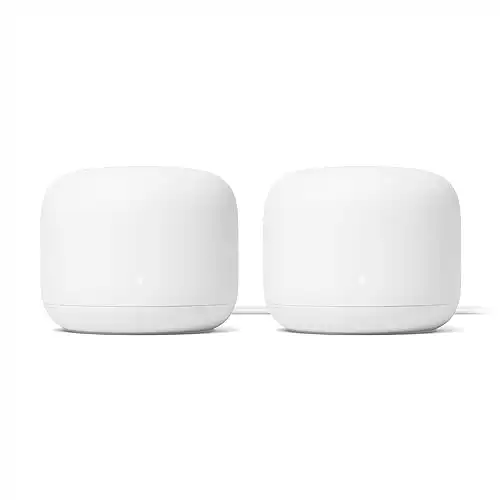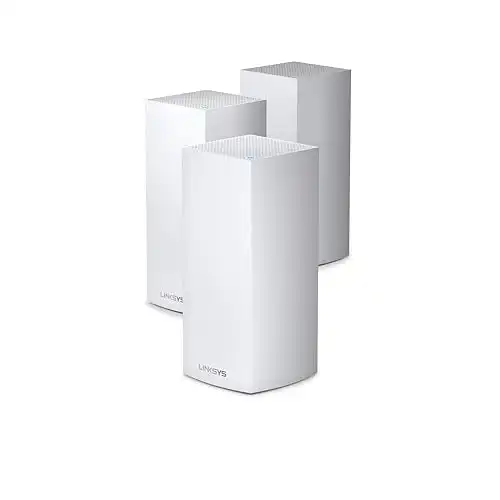The reliability of your wireless network is crucial to a properly functioning smart home. Devices can use up a lot of bandwidth (especially video doorbells and smart security cameras), and the best Wi-Fi routers for smart homes use mesh networking technology to ensure solid coverage everywhere in the home.
Mesh networking uses a set of access points, called “nodes,” to deliver Wi-Fi within the home. When placed correctly, nodes offer a far more stable (and faster) connection, which we’ve found results in dramatically better network performance.
While you could run your smart home off of a single high-performance router, in most situations, you’ll still have “dead spots.” These dead spots can cause all kinds of issues for smart home devices, leading to unnecessary frustration and a poor user experience. That’s why we only recommend mesh networking solutions: they are indeed the best Wi-Fi routers for smart home use.
Smart Home Wi-Fi FAQ
How do you pick the best wireless router for your needs? This FAQ will help you make the right choice.
In theory, yes, as long as it has more available bandwidth. You should see an improvement in WiFi speed and range by replacing your router, although your mileage will vary. WiFi signals are easily obstructed by objects like walls, pipes, and even furniture. As long as there aren’t obstructions in the way, your router speed and capacity should improve.
We strongly recommend a mesh networking system for smart home devices. These devices require a stable and fast connection to work correctly. A mesh router allows you to extend the range of your WiFi while at the same time offering a faster connection to all your smart home devices.
Most smart home devices require a 2.4GHz network to operate. Ensure your router has these frequencies enabled (on some routers, only the 5GHz network is enabled by default).
The number of devices you can have on a WiFi network will vary because each device has its bandwidth requirements. However, you should be able to have at least 30-50 smart devices simultaneously on a wireless router without too much trouble.
In a traditional router setup, all connecting devices use a single point to connect to. However, a mesh system has several points, called access points, which devices can connect to. This prevents bottlenecks and improves performance since the device is connected to the closest access point.
While a mesh network is perfect for the smart home, it’s not without its disadvantages. First, mesh routers still work on the same WiFi technologies as any other router. If your home’s layout is complex, or there are a lot of obstructions between the mesh router and any access points, any devices connecting to that access point will also be affected. Also, a mesh router is far more expensive than a standard WiFi router, which is a significant barrier.
Yes, smart routers exist! These routers go a step beyond the traditional router by intelligently, and automatically, delivering the best connection to any connected device. This is through a technology known as “beamforming.” Without getting too technical, the router boosts the signal (the “beam”) in the direction of the connecting device to ensure a more stable connection.
Wi-Fi 6 (IEEE 802.11ax) is the latest generation of wireless networking technology, succeeding Wi-Fi 5 (IEEE 802.11ac). Wi-Fi 6 offers several key advancements, including higher data rates, increased capacity, and lower latency. This translates to faster and more reliable connections, even in environments with a large number of connected devices.
Features to Look for in a Wireless Router
When shopping for a wireless router, we recommend selecting a Wi-Fi router with the following features:
- Wi-Fi Standard: Opt for a router that supports the latest Wi-Fi standards, such as Wi-Fi 6 (IEEE 802.11ax), for future-proofing your network and ensuring compatibility with newer devices.
- Dual or Tri-Band: A dual-band router can operate on both the 2.4 GHz and 5 GHz frequencies, providing two separate networks and reducing interference. Tri-band routers add a 5 GHz band for even less congestion and faster speeds. Some of the newest routers use the recently opened 6GHz band for additional speed.
- MU-MIMO Support: Multi-user, Multiple Input, Multiple Output (MU-MIMO) technology allows a router to communicate with multiple devices simultaneously, enhancing network efficiency and reducing latency.
- Quality of Service (QoS): This feature allows you to prioritize traffic for specific applications or devices. It’s particularly useful for ensuring uninterrupted video streaming or gaming experiences.
- Gigabit Ethernet Ports: Wired connections still offer the most reliable and fastest speeds. Look for routers with Gigabit Ethernet ports for high-speed local networking.
- USB Ports: USB ports can be a convenient feature for sharing printers, external hard drives, or other peripherals across your network.
- Mesh Capability: If you have a large home or office, consider a router with mesh capability. This will enable you to add extra nodes to your network, extending coverage and eliminating dead zones.
- Security Features: Look for routers with robust security options, such as WPA3 encryption, a built-in firewall, and the ability to set up a guest network. Some models also offer advanced features like VPN support and parental controls.
By paying attention to these features, you can make an informed decision and select a router that best suits your individual networking needs.
Best Wi-Fi routers for smart homes
As we have already said, the best Wi-Fi routers for smart homes use mesh networking technology. Therefore, we’ve limited our recommendations to mesh networking systems only. While we are big fans of Linksys’ Velop system (it’s what we use here at home), their high-end Wi-Fi 6-capable Velop AX4200 is quite expensive. But so is Google Nest Wifi: which many consider one of the best mesh networking platforms.
However, in most tests we’ve seen, Google Nest Wi-Fi, a Wi-Fi 5 router, bested the Velop AX4200 three-node system with only two nodes. That makes it a far better deal, plus the fact it seems to manage connections than most mesh networking systems better, resulting in a more stable connection no matter where you’re at in your home. Plus, if you use Google Assistant in the home, each node has built-in Google Assistant support to boot.
However, the Google Nest Wifi doesn’t make much sense for those not within the Google ecosystem, whether by other Nest devices or Android phones. For the rest of us, we’d recommend opting for the Eero Pro 6. While the standard Eero 6 disappoints, the Pro version offers a much better experience, easily handling traffic thanks to its tri-band radio and impressive range capabilities.
We understand if you’re taken aback by the prices of some of these routers, as they’re quite expensive. However, you’ll want to invest in a solid wireless networking setup if you plan to use more than just one or two smart home devices. The investment is worth it in the end.
Choosing the best Wi-Fi routers for smart homes
Unless you live in a small home (such as a one or two-bedroom apartment), you will need a mesh networking system for smart home use. Two and three-bedroom homes and apartments may need two nodes, while larger three-bedroom homes and four-bedroom homes should consider three nodes.
However, a quick word of caution: just as you can lose performance having your nodes too far apart, having them too close together can also cause issues. Be sure to follow the instructions included with your router to help you place your nodes at ideal spots.
The above recommendations for the best Wi-Fi routers for smart homes all score highly in the range department. We’ve found their coverage claims to be valid, so you’re safe in basing your purchase on their recommendations.


